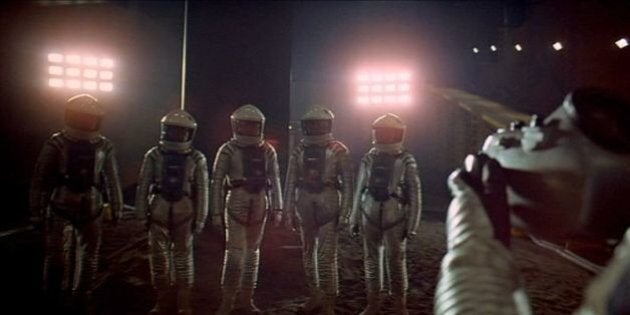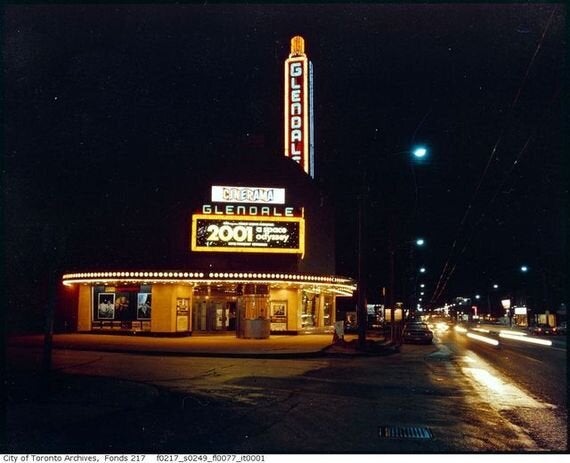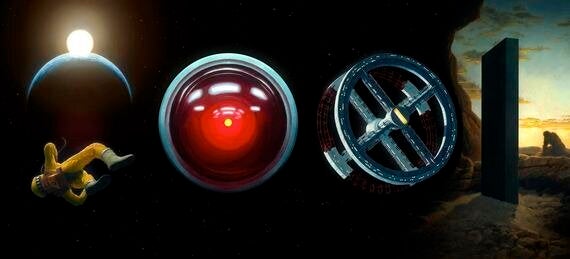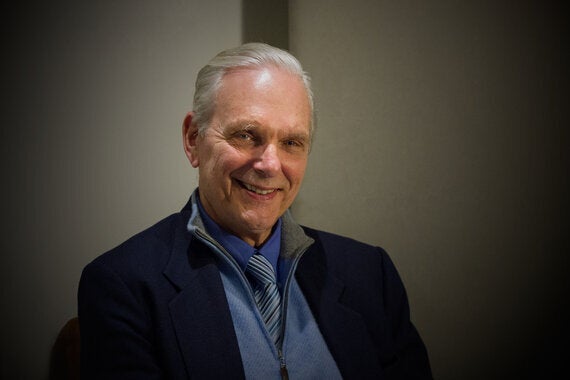
Star Wars: The Force Awakens might be taking us to a galaxy, far, far away, but way, way before even the first Star Wars did so, another science-fiction film took us much, much farther.
Fifty years ago this week, six astronauts posed on the moon for a selfie-ish photograph next to a newly uncovered three million-year old alien artifact, a towering sheer black monolith, one that was about to set us on course for an encounter with the infinite.
Well, it wasn't quite on the moon, but on an artfully constructed facsimile of it on a shooting stage in Boreham Wood Studios in the U.K. Legendary director Stanley Kubrick was there filming this scene on the very first day of shooting on what was to become the greatest science fiction film of all time, 2001: A Space Odyssey.
Although he most decidedly did NOT fake the first moon landing four years later, Kubrick didn't need to -- with 2001 he showed us not only how to get there, but why we might want to go there and beyond, and what it might all mean for us as a species.
The film's cultural importance has only grown, and part of this is because of what it did for cinematic storytelling. Star Wars may have won over the hearts and adrenal glands of moviegoers, but 2001 captivated the minds and enriched the souls of millions for over five decades -- and it's still doing it -- in widescreen 70mm no less.

I first saw it when it was released in 1968 at Toronto's long-gone Glendale Cinema, where it played for two and a half years. The visual astonishment aside, what blew me away, as a precocious 11-year-old, was seeing a film which revealed how adults actually talk -- sometimes in clipped sentences, sometimes in jargon, but always with some sort of meaning behind it all that I couldn't quite apprehend. 2001 managed to be both fantastical and realistic, with an almost documentary quality to it.
Conceived and released years before George Lucas' first Star Wars film, 2001 not only re-set the standard for what a science fiction movie could be (it could be serious, deal with big ideas and span the entire history of humanity), but it completely re-defined how a filmmaker's vision could transport an audience into the seemingly real and into the future. No one is now looking back now at 2001 and criticizing its late-1960s special effects, though to some Lucas' six Star Wars films have lost some of their original luster.
Despite astonishing advances in film technology that allow filmmakers to construct realistic characters and landscapes entirely from a computer, 2001 remains the gold standard, particularly remarkable given that much of its magic was actually constructed in a studio. Its hyper-realistic space exploration scenes were crafted by photographers, painters and old-school visual effects teams, who, under Kubrick's direction, pushed 1960s technology beyond what was thought possible. Even the motion graphics on the computer screens on the film's spacecraft had to be presented using 16mm film projectors -- for no such detailed computer imagery yet existed.
Upon its release in 1968, it gave us our first exposure to sophisticated and credible artificial intelligence -- a talking computer named HAL 9000, who turned about to be all too human and, indeed, fatally flawed at a time when a computer was something room-sized and not very chatty. The film gave us our first glimpses of Skype (a video call back to Earth from a space station phone booth) and the iPad (the astronauts' "Telepads") -- engaging us in a scientifically credible and creatively inspiring view of what life in space might be like.

Piers Bizony, author of the recent book The Making of Stanley Kubrick's '2001: A Space Odyssey', told me that "2001 has kept so much of its freshness because of the unprecedented care Kubrick took in researching the technical details and making all the hardware appear convincing. Far from looking dated, the movie presents us with a number of perfectly plausible scenarios that we haven't yet matched in real life. We should have settlements on the moon by now, and there should be private shuttles going up to orbiting space hotels. Siri talks, but she's not as smart as HAL 9000. 2001 serves as a manifesto for the future, and shows no signs of becoming redundant as an influential work of science fiction."
Unlike Star Wars: The Force Awakens, 2001 didn't show the aliens or indulge in space battles. Its stately, contemplative pace, use of genre-unusual classical music and slim dialogue (the film is 25 minutes in before a word is spoken -- unless you count ape grunts) made it stand out as something never before seen or attempted by Hollywood.
Piers Bizony: "Look at most movies, and they consist of people in rooms, talking. Kubrick set out to make a piece of cinematic art that expresses itself in images and sound, with very little dialogue. 2001 is an unequalled master class in visual storytelling."


The film's lead actor, Keir Dullea, who played mission commander Dave Bowman, recently told me that he is still experiencing, first-hand, the sustained power of the film to move people at big-screen engagements at some of the finest cinemas in the world, like Toronto's TIFF Lightbox or the American Film Institute.
"The reactions of audiences these days -- and these audiences includes a lot of young people, most of whom have only seen it on the small screen -- is extraordinary. I can't believe the number of 20-year-olds who are raving about this film. Whole audiences rising to their feet with applause. It wasn't considered an iconic film when it came out -- the initial reaction to the film is so different than it is today," he said. But it's not entirely surprising to Dullea: "with Kubrick I felt absolutely in the presence of genius."
Immersive but sometimes cryptic, moving but not overly emotional, immensely satisfying but demanding, 2001 does that Star Wars can never do -- include us in considering the mystery, plumbing the depths of our own imaginations.
In our fractured time, in which the big screen competes for our attention with thousands of smaller ones all around us, we construct our own narratives daily and search not so much for more and more information, but for meaning.
2001, 50 years after it started shooting, and 15 years after the actual year 2001 passed, is still doing that for us. Maybe Kubrick's 2001 collaborator, novelist and science writer Arthur C. Clarke wasn't wrong when he said during the film's production, "MGM doesn't know this yet, but they're paying for the first $10,000,000 religious movie."
Cover artwork from The Making of Stanley Kubrick's '2001: A Space Odyssey': M/M Paris/Wayne Haag
Glendale Cinema photo: City of Toronto Archives
Keir Dullea photo: Aisha Goyette
All images from 2001: A Space Odyssey copyright (c) 1968 Turner Entertainment, by arrangement with Warner Bros. Entertainment Inc.
MORE ON HUFFPOST: